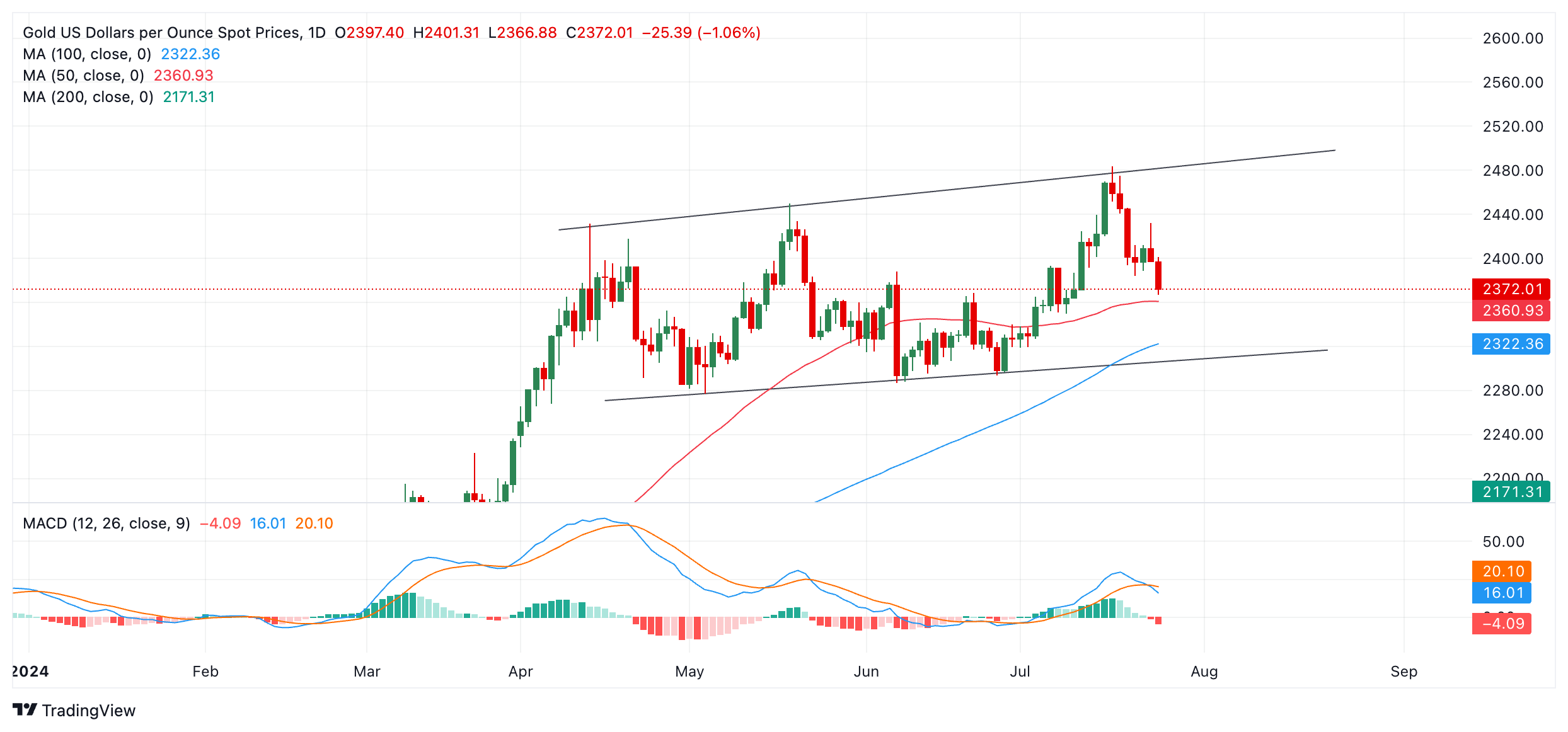- Gold extends its sell-off after the release of US GDP data.
- The precious metal shrugs off the global growth fears that normally incentivize investors to hoard Gold.
- Gold joins most other commodities as they sell off.
Gold (XAU/USD) extends its sell-off after the release of robust US data on Thursday. It is trading over a percentage point lower in the $2,370s amid widespread declines in stocks and commodities driven by global growth concerns.
Despite being a safe haven, Gold's weakness is partly attributable to technical selling, as it experiences a predicted downward movement within its trading range. Favorable US data, including preliminary Q2 Gross Domestic Product data and preliminary US S&P Global Purchasing Managers Index (PMI) data for July, released on Wednesday may have dampened growing fears of "stagflation," which is characterized by economic weakness coupled with high inflation — a scenario where Gold typically performs well.
Gold falls on technical selling and US data
Gold declines on Thursday after data showed preliminary Q2 GDP growth rose by 2.8% on a annualized basis, beating estimates of 2.0% and the previous quarter's 1.4%, according to data from the US Bureau of Economic Analysis. The data suggests the US economy is in relatively good shape and allays fears of stagflation after the run of underpar US data of recent weeks. It suggests the Federal Reserve (Fed) will not be in a hurry to lower interest rates but will probably take a more measured approach. The increased likelihood of interest rates remaining relatively high for longer is negative for Gold as it makes the non-interest bearing asset less attractive to investors.
Other US data released on Thursday painted a mixed picture, with Durable Goods Orders falling by 6.6% in June but Jobless Claims edging lower.
Gold was already trading on the back foot after the US S&P Global Composite PMI improved to 55 in July from 54.8 in June, on Wednesday. The S&P Global Manufacturing PMI, however, declined to 49.5 from 51.6, while the Services PMI rose to 56.0 from 55.3.
Chris Williamson, Chief Business Economist at S&P Global Market Intelligence, noted, "The flash PMI data signal a ‘Goldilocks’ scenario at the start of the third quarter, with the economy growing at a robust pace while inflation moderates." He added, "In terms of inflation, the July survey saw input costs rise at an increased rate, linked to rising raw material, shipping, and labor costs. These higher costs could feed through to higher selling prices if sustained, or cause a squeeze on margins."
Gold's decline comes despite continued expectations that the Federal Reserve (Fed) will cut interest rates multiple times before the year's end. Lower interest rates generally make non-interest-bearing assets like Gold more attractive, boosting demand.
Meanwhile, there has been some unwinding of the "Trump trade," which has dragged US bond yields lower, positively impacting Gold. In some polls, US Vice president and Democrat candidate Kamala Harris now leads Republican leader and former US President Donald Trump, suggesting a potentially less inflationary outlook for the economy if she wins.
Additionally, there are expectations of increased physical demand from India, the world’s second-largest Gold consumer, following the government's reduction of its Gold import tax from 15% to 6%.
Gold is also expected to benefit from long-term geopolitical factors, particularly plans by BRICS+ nations to replace the US Dollar as the world’s reserve currency with their own Gold-backed alternative. This move aims to prevent the US from leveraging the Dollar in geopolitical conflicts and sanctions against enemy states.
Technical Analysis: Gold continues oscillating in range
Gold is unfolding a new down leg within the widening range it has formed since May. It still appears to be within a sideways market mode rather than a directional trend.
The down leg is expected to fall towards the floor and the 100-day Simple Moving Average (SMA) at circa $2,320. However, the 50-day SMA at $2,360 is likely to present temporary support on the way down.
XAU/USD Daily Chart
The Moving Average Convergence Divergence (MACD) indicator has crossed below its signal line, adding bearish confirmation to the down move currently unfolding. MACD tends to work particularly well at signaling price turns in sideways markets.
A break above the $2,483 all-time-high would indicate the establishment of a higher high and suggest the possibility of a breakout to the upside and an extension of the longer-term uptrend.
Such a move might unlock Gold’s next upside target at roughly $2,555-$2,560, calculated by extrapolating the 0.618 Fibonacci ratio of the height of the range higher.
Economic Indicator
Gross Domestic Product Annualized
The real Gross Domestic Product (GDP) Annualized, released quarterly by the US Bureau of Economic Analysis, measures the value of the final goods and services produced in the United States in a given period of time. Changes in GDP are the most popular indicator of the nation’s overall economic health. The data is expressed at an annualized rate, which means that the rate has been adjusted to reflect the amount GDP would have changed over a year’s time, had it continued to grow at that specific rate. Generally speaking, a high reading is seen as bullish for the US Dollar (USD), while a low reading is seen as bearish.
Read more.Last release: Thu Jul 25, 2024 12:30 (Prel)
Frequency: Quarterly
Actual: 2.8%
Consensus: 2%
Previous: 1.4%
Source: US Bureau of Economic Analysis
The US Bureau of Economic Analysis (BEA) releases the Gross Domestic Product (GDP) growth on an annualized basis for each quarter. After publishing the first estimate, the BEA revises the data two more times, with the third release representing the final reading. Usually, the first estimate is the main market mover and a positive surprise is seen as a USD-positive development while a disappointing print is likely to weigh on the greenback. Market participants usually dismiss the second and third releases as they are generally not significant enough to meaningfully alter the growth picture.
Information on these pages contains forward-looking statements that involve risks and uncertainties. Markets and instruments profiled on this page are for informational purposes only and should not in any way come across as a recommendation to buy or sell in these assets. You should do your own thorough research before making any investment decisions. FXStreet does not in any way guarantee that this information is free from mistakes, errors, or material misstatements. It also does not guarantee that this information is of a timely nature. Investing in Open Markets involves a great deal of risk, including the loss of all or a portion of your investment, as well as emotional distress. All risks, losses and costs associated with investing, including total loss of principal, are your responsibility. The views and opinions expressed in this article are those of the authors and do not necessarily reflect the official policy or position of FXStreet nor its advertisers. The author will not be held responsible for information that is found at the end of links posted on this page.
If not otherwise explicitly mentioned in the body of the article, at the time of writing, the author has no position in any stock mentioned in this article and no business relationship with any company mentioned. The author has not received compensation for writing this article, other than from FXStreet.
FXStreet and the author do not provide personalized recommendations. The author makes no representations as to the accuracy, completeness, or suitability of this information. FXStreet and the author will not be liable for any errors, omissions or any losses, injuries or damages arising from this information and its display or use. Errors and omissions excepted.
The author and FXStreet are not registered investment advisors and nothing in this article is intended to be investment advice.
Recommended content
Editors’ Picks

NZD/USD trims gains to near 0.5850 as RBNZ Orr speaks
NZD/USD has trimmed gains to reverse near 0.5850 early Wednesday. The New Zealand Dollar found fresh buyers after the RBNZ announced 50 bps interest rate cut to 4.25%, as widely expecteed but RBNZ Governor Orr's prudent remarks check the pair's upside.

USD/JPY stays pressured below 153.00, US data eyed
USD/JPY slides to over a two-week low below 153.00 early Wednesday as Trump's tariff threats continue to drive haven flows towards the JPY and exert pressure on spot prices. That said, doubts over the BoJ's ability to tighten its monetary policy further should cap gains for the JPY. US data eyed.

Gold price consolidates amid mixed cues; holds comfortably above $2,600
Gold price struggles to capitalize on the overnight bounce from the $2,600 neighborhood or over a one-week low and trades with a mild negative bias on Wednesday. The prevalent risk-on environment, expectations for a less dovish Fed, elevated US bond yields and the underlying bullish sentiment surrounding the USD act as a headwind for the commodity.

Bitcoin remains short of $100K as long-term holders capitalize on recent price rise
Bitcoin (BTC) trades below $95K on Tuesday following increased selling pressure among long-term holders (LTH) after a series of new all-time highs (ATH).

Eurozone PMI sounds the alarm about growth once more
The composite PMI dropped from 50 to 48.1, once more stressing growth concerns for the eurozone. Hard data has actually come in better than expected recently – so ahead of the December meeting, the ECB has to figure out whether this is the PMI crying wolf or whether it should take this signal seriously. We think it’s the latter.

Best Forex Brokers with Low Spreads
VERIFIED Low spreads are crucial for reducing trading costs. Explore top Forex brokers offering competitive spreads and high leverage. Compare options for EUR/USD, GBP/USD, USD/JPY, and Gold.
